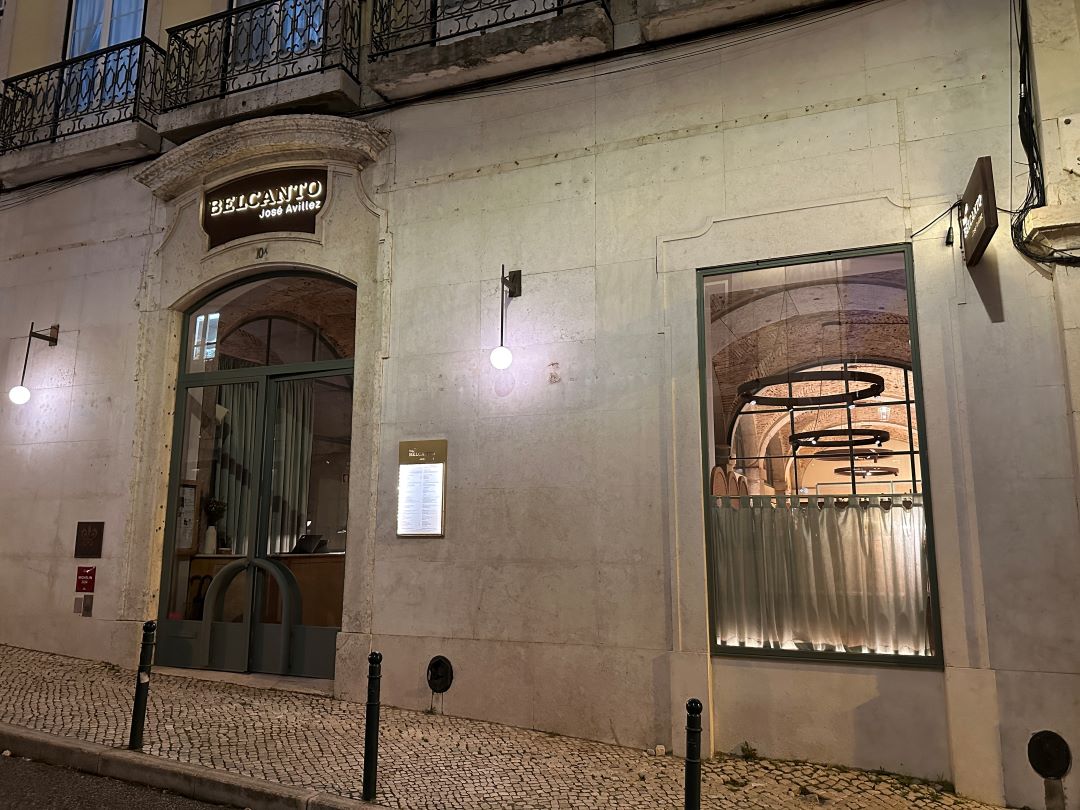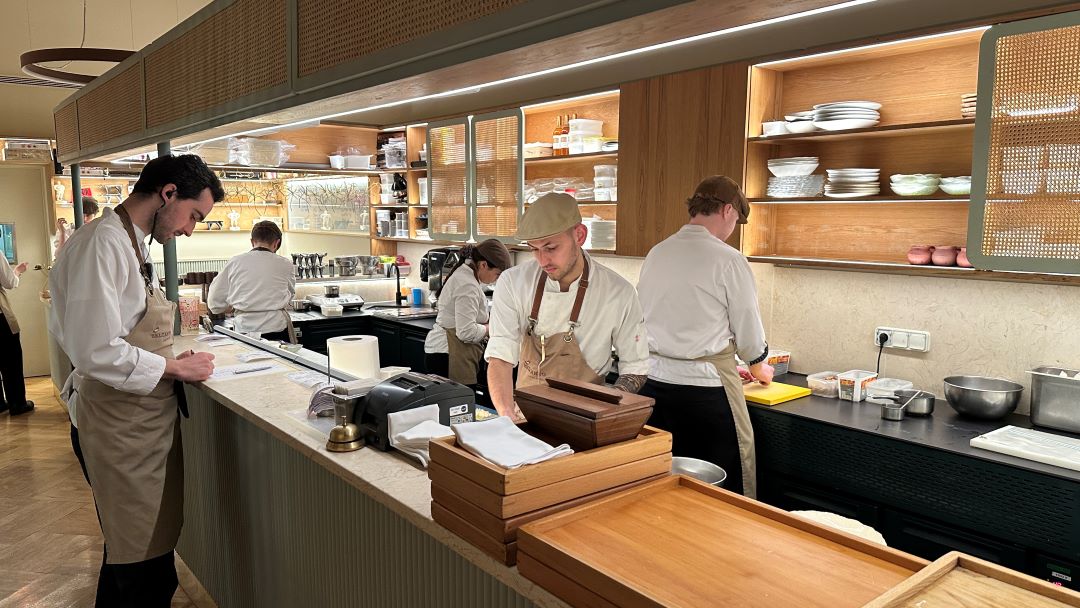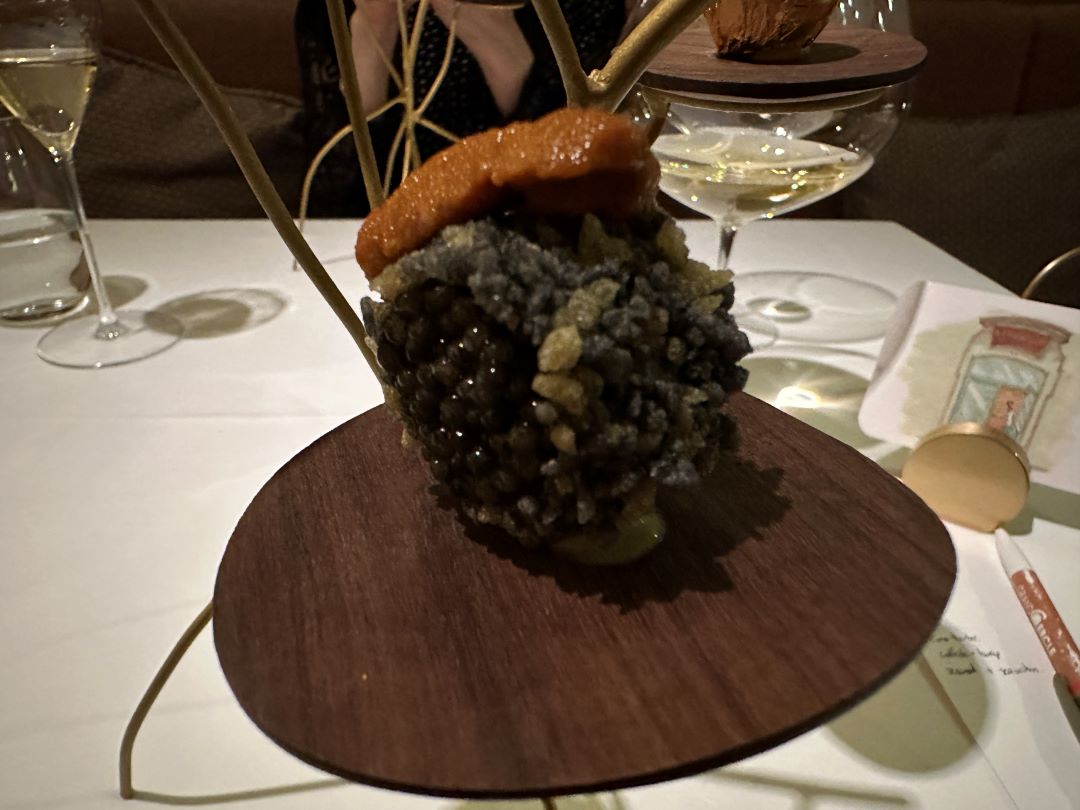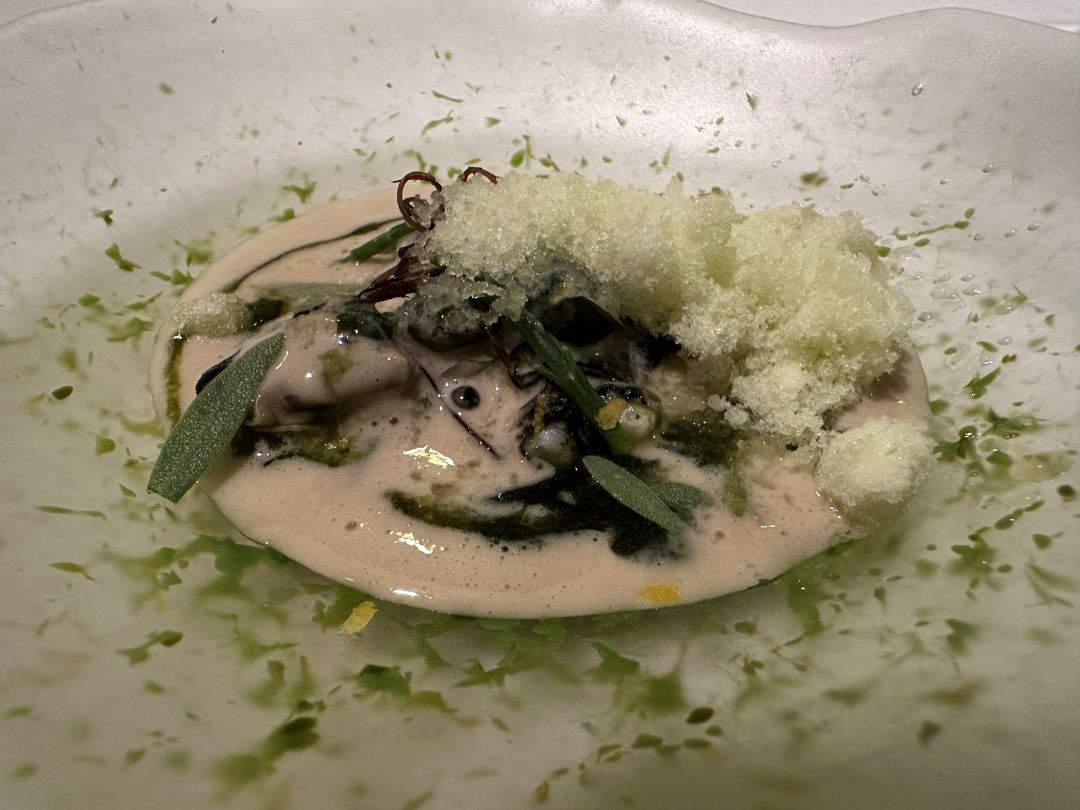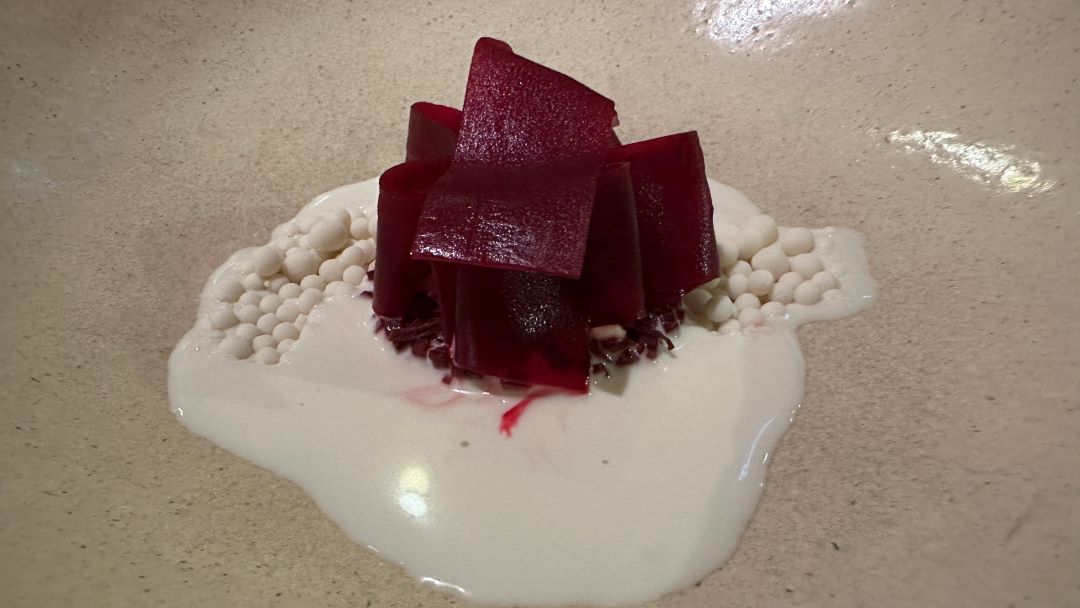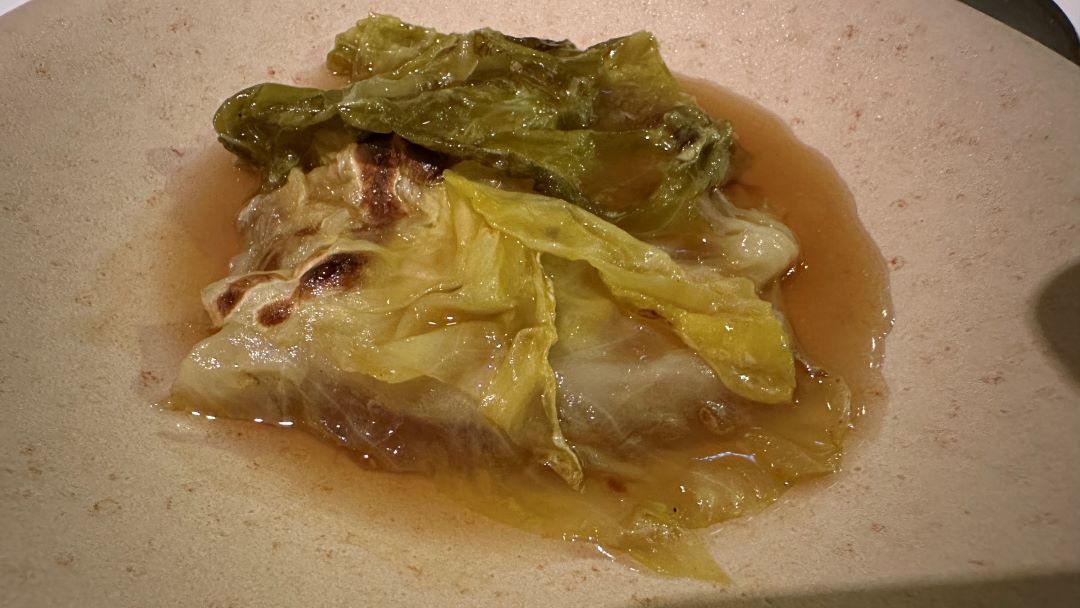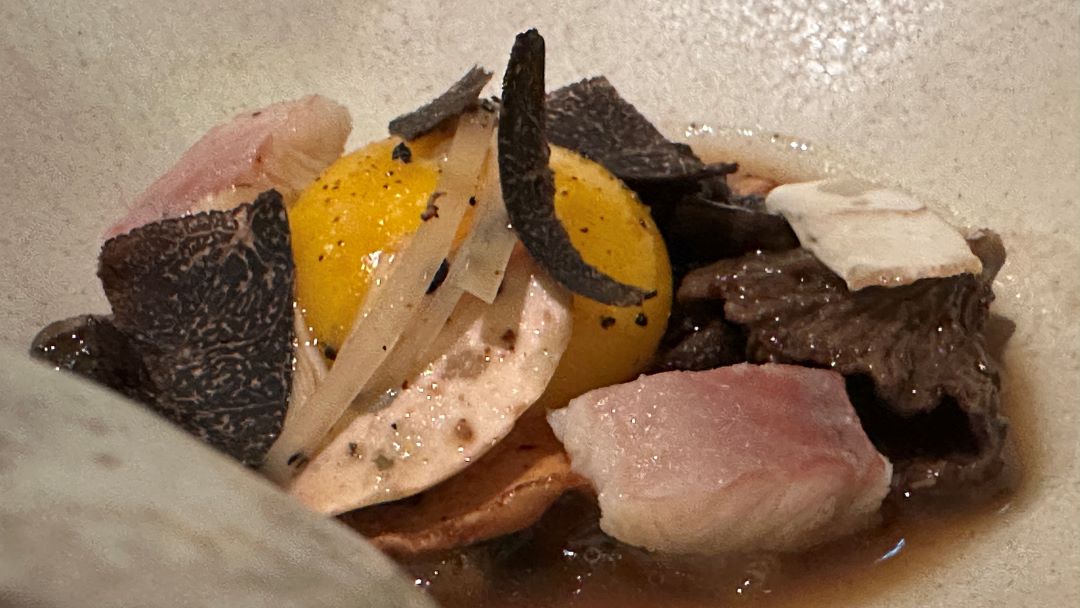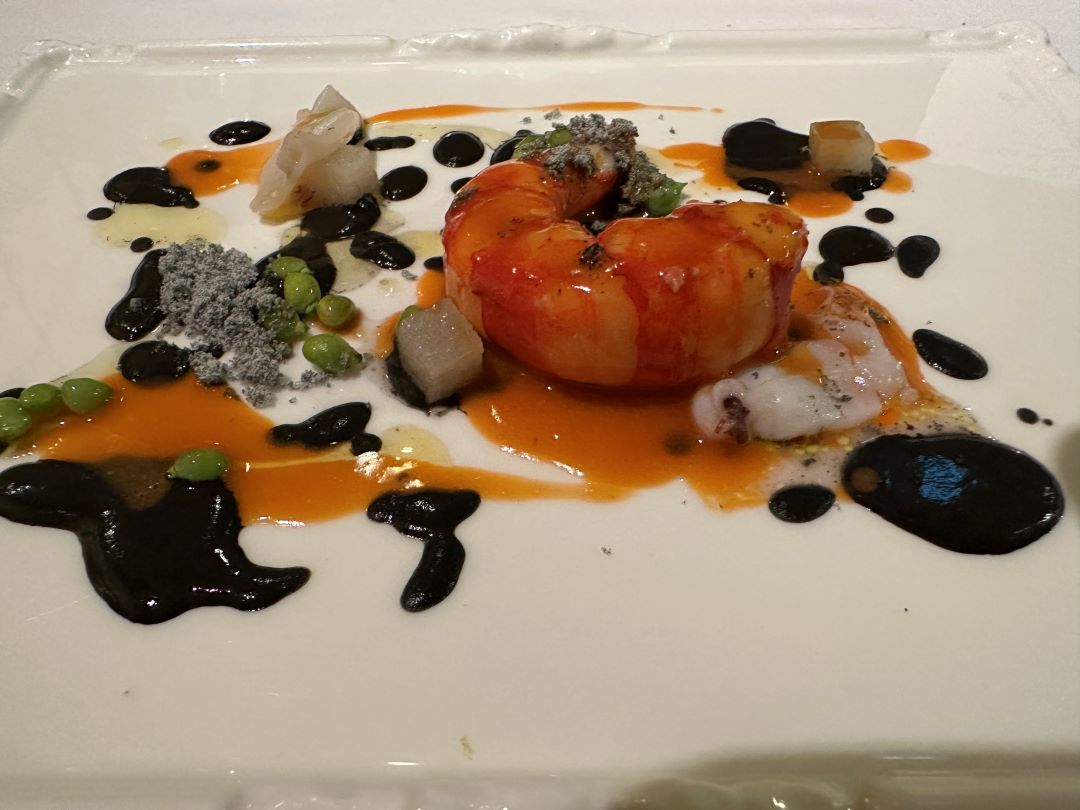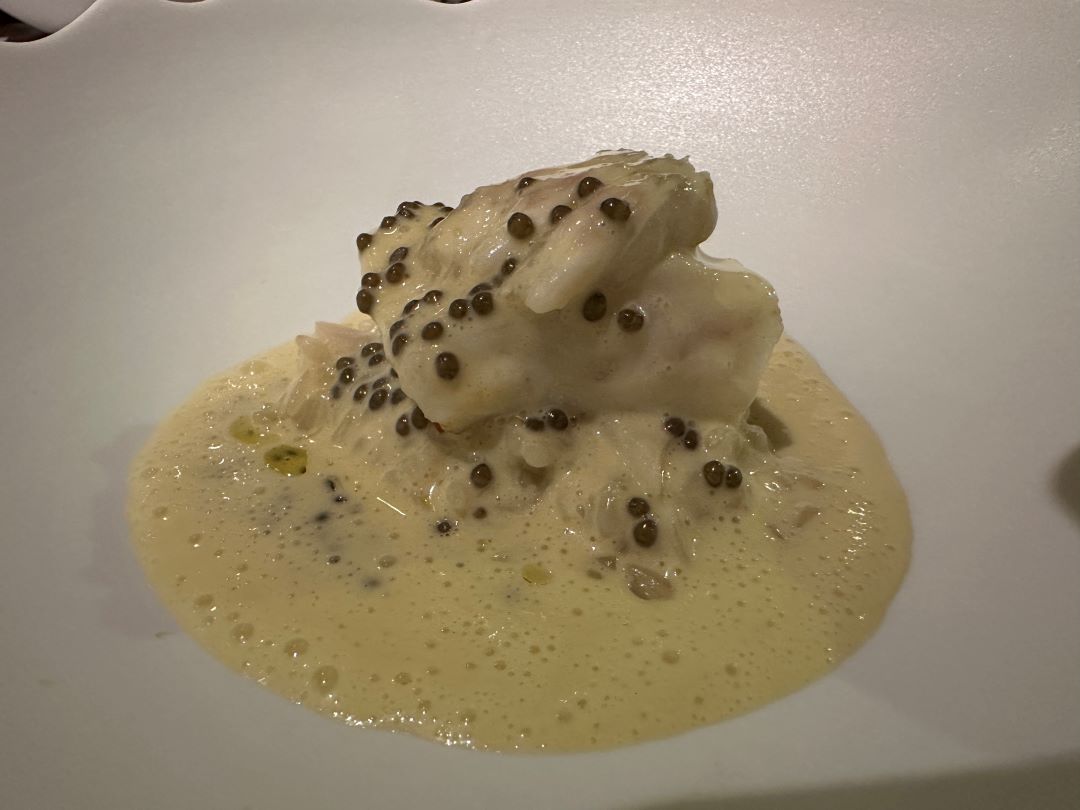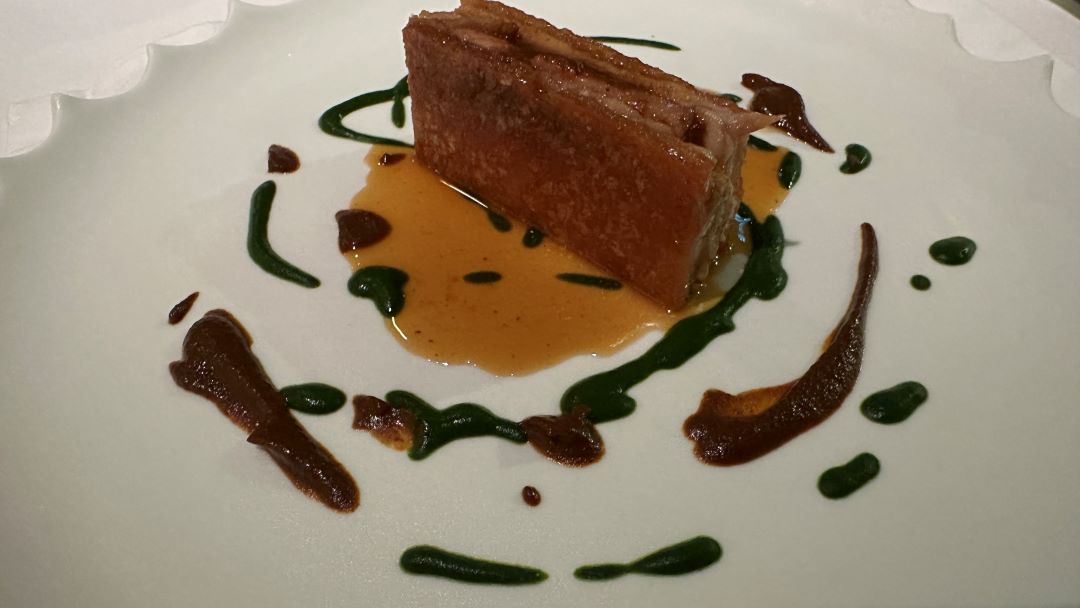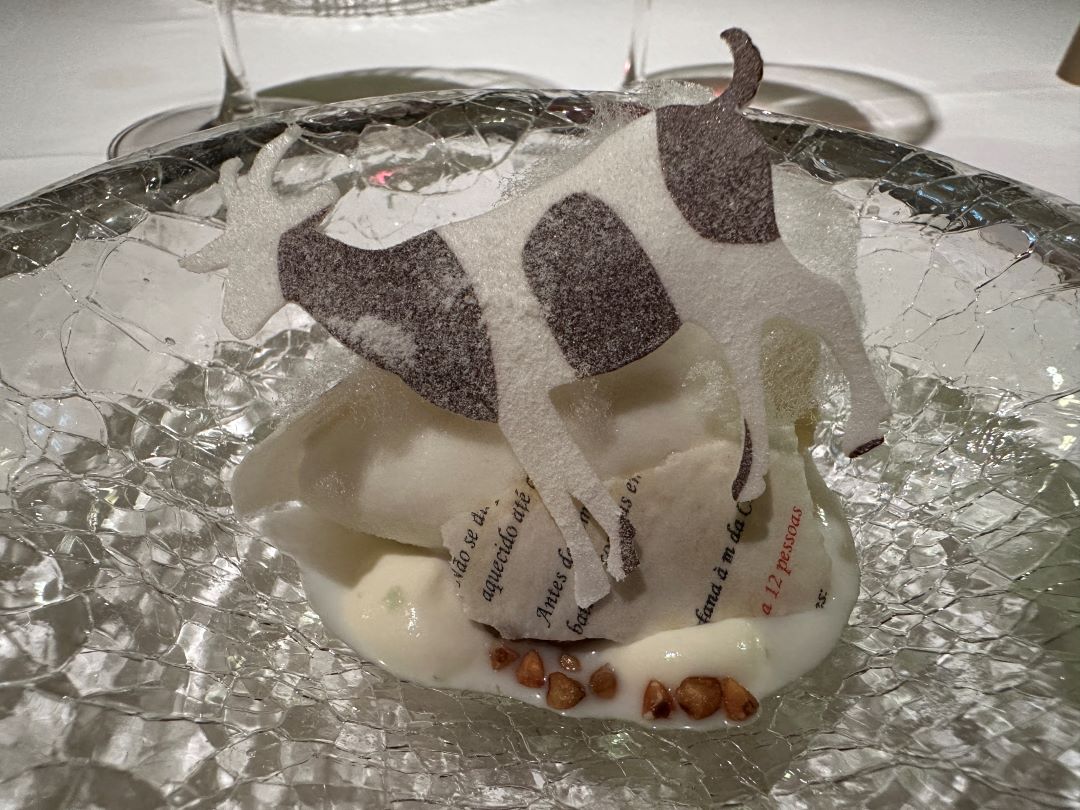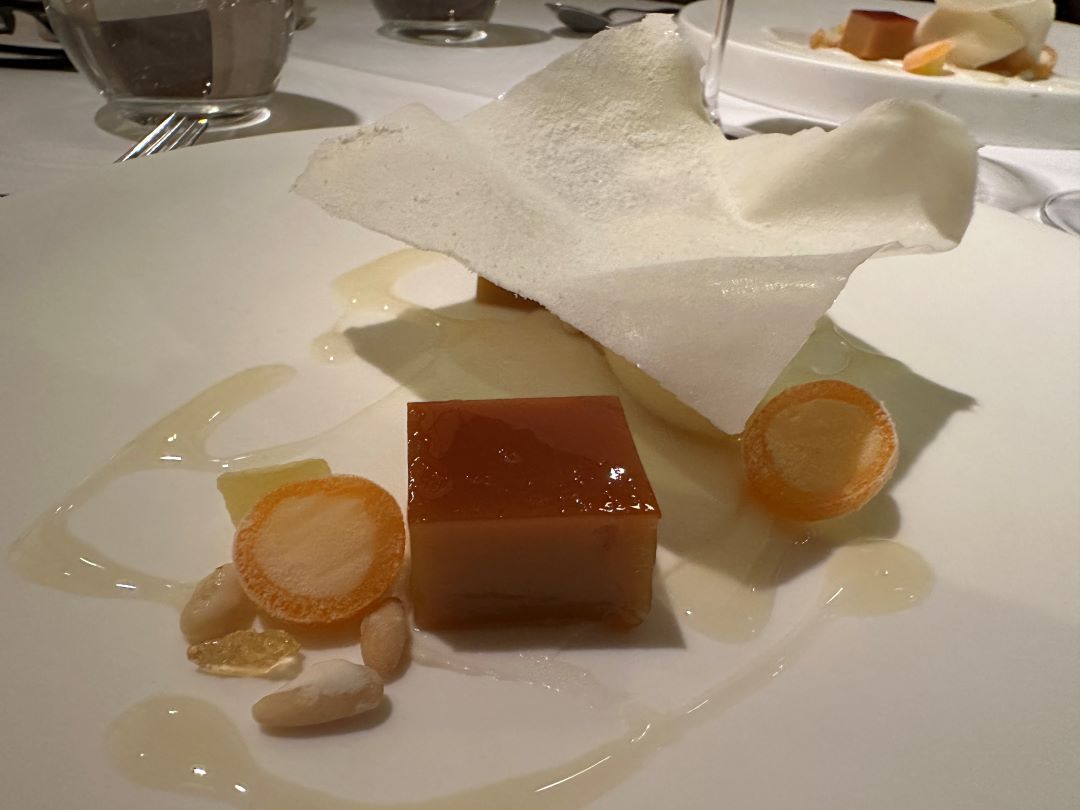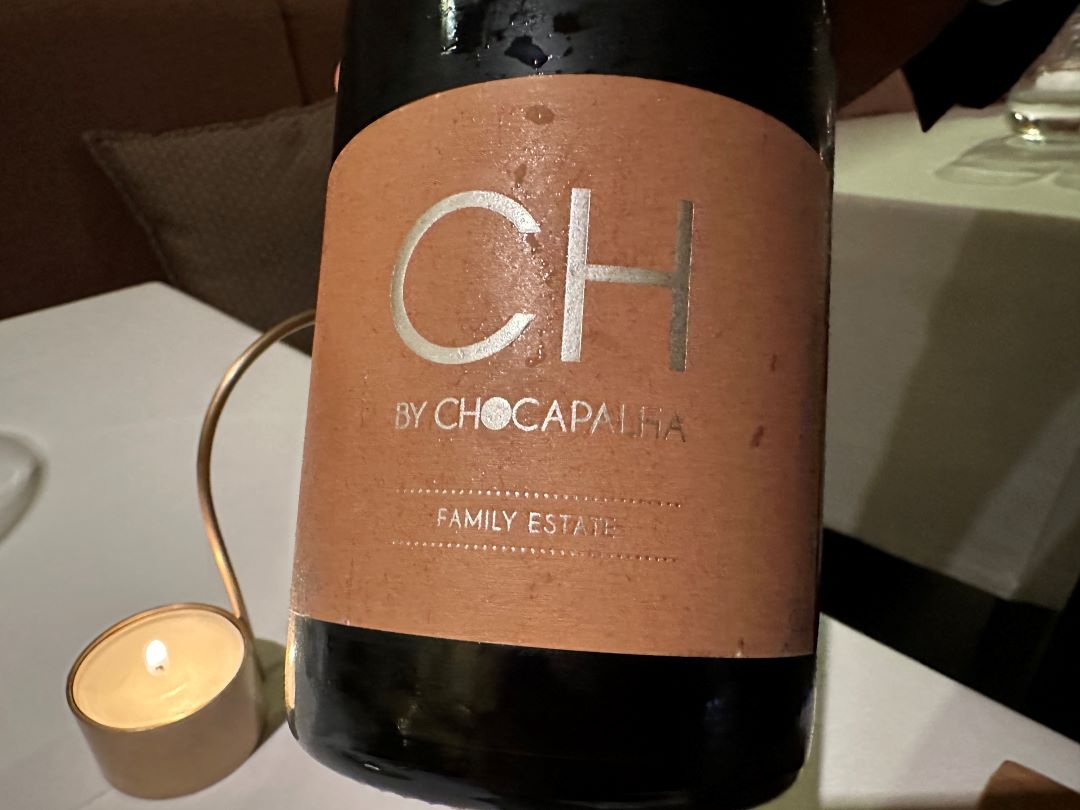Browse using the new Vinous website now. Launch →
Printed by, and for the sole use of . All rights reserved © 2015 Vinous Media
R. Serpa Pinto 10A,
1200-026 Lisbon,
Portugal
+351 21 342 0607
BY NEAL MARTIN | MAY 2, 2025
The Food:
Amuse-bouche
Oysters, seaweed, samphire with apple and cucumber granita
Beetroot, pine nut milk and mustard seeds
Hamachi, cabbage and broth of “Cozido à Portuguesa”
Egg yolk, eel, black truffle with parsley puree
Scarlet shrimp and “barefoot cuttlefish”
Turbot, razor clams-infused Carnaroli rice and caviar
Suckling pig, mole of Sarrabulho with watercress emulsion
Goats’ milk, squeezed lime ice cream, fig, toasted buckwheat and cotton candy
“Abade de Priscos”: pine nut gel, yuzu sorbet and kumquat with dehydrated yoghurt wafer
Petits-fours
The Wines:
2022 Quinta de Chocapalha CH by Chocapalha - 88
2021 Giz Vinhas Velhas Red - 88
2022 António Maçanita Tinta Negra Dos Villões - 93
Lisbon has become one of Europe’s great gastronomic centres. It’s not quite the Mecca that is San Sebastián. Nonetheless, epicures descend into the Portuguese capital to devour as many Pasteis de Nata as humanly possible (I recommend a pilgrimage to the ubiquitous custard tart’s birthplace at Pasteis de Belém, a short ride out of the city) or to savour world-class cuisine at one of the city’s 17 Michelin-starred restaurants. Lisbon caters to gourmands of all types, especially those with pescatarian leanings, since the Atlantic lies just yonder at the end of the Tagus estuary.
I strive to include restaurants of varying levels in my Vinous Tables. On my first trip to Libson two years ago, I focused on institutions such as Solar dos Presentos and Cervejaria Ramiro. On this, my second sojourn, I reserved a table at what is generally regarded as Lisbon’s finest restaurant—Belcanto. José Avillez is to Portugal what Thomas Keller is to the U.S., or Gordon Ramsay to the U.K.: a gifted, renowned chef who became a public figure with attendant books and TV appearances. Opened in 2012, Belcanto became the first Portuguese restaurant to win two Michelin stars and is listed at number 31 in San Pellegrino’s “World’s 50 Best Restaurants.” In recent years, Avillez has built a small empire of eateries around Portugal, including the one-star “Encanto” next door, but Belcanto is the jewel in the crown.
The façade of Belcanto.
The restaurant is located in the Chiado district in the heart of Lisbon: an epicentre of gastronomic temples (two-starred “rival” Alma is the next block down…you could feasibly do both in a day!) Belcanto lies close to the opera theatre, hence its name. The interior is sober and neutral: dark wood and brass, ambient lighting, minimalist half-circle mirrors on the walls, a discrete nod to 70s aesthetics. The room feels warm and inviting. The vaulted ceiling exposes the original brickwork and telegraphs a sense of history overhead, a neat juxtaposition against the modern open kitchen with what felt like multiple stations. A mezzanine houses a private dining room, and there’s a chef’s table deep inside the kitchen for those who want to get up close and personal. There is plenty of space between the white-clothed dining tables, though you can still lean over and chat if you wish.
The team hard at work in the restaurant's open kitchen.
Before broaching the menu, let me state that this was one of the finest restaurant services that I have ever encountered. I don’t refer only to the politeness of the smartly dressed waiters in their white gloves. I’m talking about the warmth of their welcome and affability—serious, but happy to joke. The preprandial request to let them know if you require the restroom so they can pause service. The invitation to tour the kitchen, where I was warmly greeting by kitchen staff, communicating that I was welcome to curiously nose about. Then, there are the small gestures. Before the first course, we are given a card that simply says “Welcome,” and then each course is preceded by another card with an illustration on one side and ad hoc words, pointers to imminent dishes on the flipside. Each one is slotted into a brass holder on the table, then at the end of the meal, your pack is whisked away and returned in a sealed wax envelop with an added personal message from the team and even Avillez’s signature. These multiple gestures made the whole experience feel personal, familial, almost wistful—leitmotifs of the dining experience.
Belcanto offers à la carte options at 225 and 250 euros per person. Frankly, you are much better advised to go for the tasting “discovery” menu at 265 euros. Expensive? No kidding. But that is the going rate for dining at this level. Moreover, I could mention several inferior restaurants in London that cost more. In my opinion, given the quality offered, this represents acceptable value, and apropos Belcanto and indeed all restaurants in Portugal, there is a pecuniary advantage for wine-lovers that I’ll broach later.
The four-part amuse-bouche.
The meal begins with a four-part amuse-bouche exquisitely arranged on a tree-like metal sculpture, one miniature platform for each. Firstly, a tiny tartlet of fatty tuna tartare. One mouthful that is to die for. I could have finished there and departed happy (almost). Secondly, a small cupcake made of codfish and turnip that delivered satisfying earth and sea flavours. Then, a small golden ball that looked like an after-dinner chocolate. In fact, this is partridge and Escabeche delicately wrapped in edible gold leaf, a grain of salt on top. Finally, what looks like a blackcurrant pastille is in fact seaweed cannelloni topped with a small, glistening lobe of sea urchin roe. The texture is amazing. It collapses in the mouth, releasing sublime saline/marine flavours that are countered by the sweetness of the urchin.
Oysters, seaweed, samphire with apple and cucumber granita.
The following dish is the most arresting and uncompromising, in a good way. Our newly delivered card simply reads “Sea,” and the dish evokes that word like few dishes I have tasted. It consists of an oyster sauce—the bivalves caught in Guincho, down the Portuguese coast towards Cascais—however, the star of the show, the trick up its sleeve, is the seaweed, or more accurately, kelp. Avillez uses kelp to form tiny ribbons and keeps its air bladders, which you gently crush between your teeth. It tastes much sweeter than you would expect and imparts an umami sensation unlike anything I’ve experienced. The dish is topped with samphire, plus a sharp green apple and cucumber granita that enhances the freshness. A startling and remarkable creation.
Beetroot, pine nut milk and mustard seeds.
Next is “Earth.” This is another incredible plate centred around the humble beetroot, sliced into a thin ribbon and served with pine nut milk, fried sweet potato and mustard seeds. It looks amazing: stark red and milk white. The beetroot is perfectly al dente and the pine nut milk delivers a nuanced sweetness that marries beautifully with the beetroot’s earthiness.
Hamachi, cabbage and broth of “Cozido à Portuguesa.”
We move to hamachi, cabbage and broth of “Cozido à Portuguesa.” Hamachi is the Japanese word for yellowtail, a pescatarian delicacy and not the easiest “finned friend” to catch. The cabbage itself is fermented and grilled, mixed with a broth made from sausage and various meats. It looks rustic and lacks the aestheticism of the previous two dishes. I would say that here, the nuanced flavours of the yellowtail are a bit lost in the broth, although I enjoyed the cabbage (four words that my mum would never believe I would ever write when I was a kid refusing to even acknowledge the cabbage on my plate).
Egg yolk, eel, black truffle with parsley puree.
The confit of egg yolk is served with smoked and grilled eel, mushrooms and black truffle with parsley puree, added to an eel and poultry jus. Our waiter advises us to pop the yolk first. This is just gorgeous. Strangely, our card says “seasonal,” but this dish is so autumnal in late March! It’s warm and filling, each element beautifully combined. The eel takes a back seat—it’s all about the egg and fungi.
Scarlet shrimp and “barefoot cuttlefish.”
The following dish is scarlet shrimp and “barefoot cuttlefish.” The scarlet shrimp, a well-known Portuguese delicacy, is heavenly, though I could have eaten mine a notch warmer. The cuttlefish is actually cuttlefish ink, served with squid and smoked bacon, so it ends up being quite rich in style. I wonder if the smoked bacon is superfluous in this instance.
Turbot, razor clams-infused Carnaroli rice and caviar.
I prefer the following dish that is built around fresh turbot placed on top of razor-clam-infused Carnaroli rice that adds a creamy texture, with black caviar. This is rich yet paradoxically nuanced in flavour, the caviar lending saltiness to counterbalance the sweetness emanating from the rice.
Suckling pig, mole of Sarrabulho with watercress emulsion.
The solitary meat dish is suckling pig. It is served like a wafer with either side consisting of a gossamer-thin crackling. The plate is drizzled with mole of Sarrabulho, a Portuguese stew made from tripe and blood, plus a watercress emulsion. This is very intense, to the point where I feel it risks unbalancing the entire tasting dinner. That does not infer that it’s not absolutely delicious and brilliantly executed, but in retrospect, I would have preferred a meat dish containing less richness than suckling pig.
Goats’ milk, squeezed lime ice cream, fig, toasted buckwheat and cotton candy.
We move to the pre-dessert, and our card has written on it: “grandmother’s recipe,” “childhood” and “fig tree”. Our waiter takes away the napkin and presents a white cotton sleeve, advising us to put it on. This is because Avillez used to wipe his mouth with his sleeve as a kid. It’s novel, a bit of sentimental theatre…why not? There is a cutout of a goat on edible rice paper served with warmed goats’ milk and squeezed lime ice cream, fig, toasted buckwheat and cotton candy. It’s small and all the better for it: light yet perfectly balanced. It does the job in fomenting feelings of childhood, though my desserts rarely exceeded “Arctic Roll,” nor did I wipe my mouth on my sleeve.
“Abade de Priscos”: pine nut gel, yuzu sorbet and kumquat with dehydrated yoghurt wafer.
Petits-fours.
The final course, the main dessert, is “abade de Priscos” that comprises a pine nut gel, yuzu sorbet and kumquat with a brittle wafer made from dehydrated yoghurt. This is another divine dessert, the wafer so nuanced and milky sweet to counter the sharpness of the sorbet. Finally, four petits fours, each served in its own teardrop-shaped wooden box.
Around 80% of the wine list is made up of Portuguese wines, though there is a fairly deep selection from elsewhere, including blue chips from Bordeaux and Burgundy. I suppose the question is why? Sure, there are customers that want to drop a bomb on a bottle of Petrus and, lest we forget, doing so helps the bottom line for any restaurant, irrespective of status. But as more restaurants reconfigure menus around vegetables and fish, reflecting changing tastes fuelled by greater interest in healthy eating, it begs the question: where does that leave red wine? Especially more structured and tannic reds. I’m thinking of the very high end here. I think of how Brett Graham at The Ledbury shifted his menu away from meat with intense reduction sauces post-pandemic. Or the single meat dish at Osip. Now here at Belcanto, and elsewhere. Is this a European movement? The United States seems more faithful to multi-meat menus, or maybe that is just happenstance. I would be interested to hear thoughts on this matter.
Belcanto offers a three-tier wine-pairing menu that starts at 150 euros per person. I am not against wine-pairing menus, especially as it offers chance to demonstrate sommeliers’ skills. However, two things dissuade me. Firstly, the wines are nearly always served via Coravin, a device without which wine-pairing menus would vanish overnight. However, I don’t really like wines served via Coravin because I find it can alter the taste, plus it makes the ritual of serving wine a little sterile. Call me old fashioned, but I like the sound of a popping cork more than the hiss of a Coravin.
Secondly, at least in Portugal, there are bountiful domestic whites and reds that mean some of the king’s ransom for the set menu can be offset by the 50-70 euros you pay for a great Portuguese wine. This is in stark contrast to Burgundy, where you have to shell out a three-figure sum for a halfway-decent Chardonnay or Pinot Noir. So, I forego the generous offer of 35 euro corkage per bottle—far less corkage than other establishments, if offered at all—and order a bottle of white.
The 2022
CH by Chocapalha from Quinta de Chocapalha comes from the Lisbon
wine region. It is 100% Arinto that undergoes nine months of bâtonnage. It is
quite Burgundian on the nose, with pleasant almond and vanilla scents that are
not overpowering. The palate is quite leesy with a decent line of acidity. It
is perfectly pleasant, though to be honest, I feel it lacks some personality. A
technically proficient white Portuguese wine, but it follows an impeccable 2022
Branco from António Madeira that blew me away a couple of nights earlier.
The 2021 Vinhas Velhas Red from Giz (which translates to “chalk”) comes from winemaker Luis Gomes, who farms century-old Baja vines in Barriada. It was aged in French oak for 20 months. This is young and primal on the nose with precocious black cherries and a touch of sloes intermixed with liquorice. The palate is likewise structured and primal, I would say 12 to 18 months away from its drinking window. The tannins are quite grippy, partly due to the oak regime, and the fruit is a powerful array of black cherry, cassis and blueberry, though it lacks a little nuance and elegance on the finish. The 2021 is outclassed by the wonderful 2022 Tinta Negra Dos Villões from António Maçanita from the island of Madeira, which is, of course, synonymous with its namesake fortified wines. This was a real eye-opener. This cuvée is 70% destemmed and after a 40-day skin maceration, matured in 228-litre oak barrels. Our sommelier advised that it is not unlike a Gamay, and he was dead on the money: vivacious Morello cherry, wild strawberry and orange zest spring from the glass with wonderful delineation. The palate delivers exquisite balance with edgy red fruit, very tensile yet supremely focused, with a touch of piquancy on the finish. Maçanita produces wine in several other areas, including the Azores, and this bottle makes me want to try all of them!
Does Belcanto live up to the billing? It was unequivocally a memorable dining experience and certainly merits its two Michelin stars. I would not describe it as completely faultless. At the end of the meal, our waiter asked what our favourite dish was, and then our least favourite. The question caught me off guard, but it showed that they do respect feedback. I must admit being completely stuffed by the time I reached the suckling pig, even after missing out on lunch during the day. The dishes are not heavy, nor do they utilise tubs of butter like in France. Perhaps it was the intensity of flavours that accreted with each course? That is my only quibble.
However, the service was second to none, and what a novelty to be dining in a Michelin-starred restaurant with plenty of affordable bottles on offer. The setting is gorgeous. You depart feeling as if you have been on a gustatory journey with José Avillez, which is part of his intention. If you want to taste high-level cuisine without pretentiousness, then Belcanto comes highly recommended. Plus, you can wipe your mucky mouth on your sleeve…
© 2025, Vinous. No portion of this article may be copied, shared or redistributed without prior consent from Vinous. Doing so is not only a violation of our copyright but also threatens the survival of independent wine criticism.

